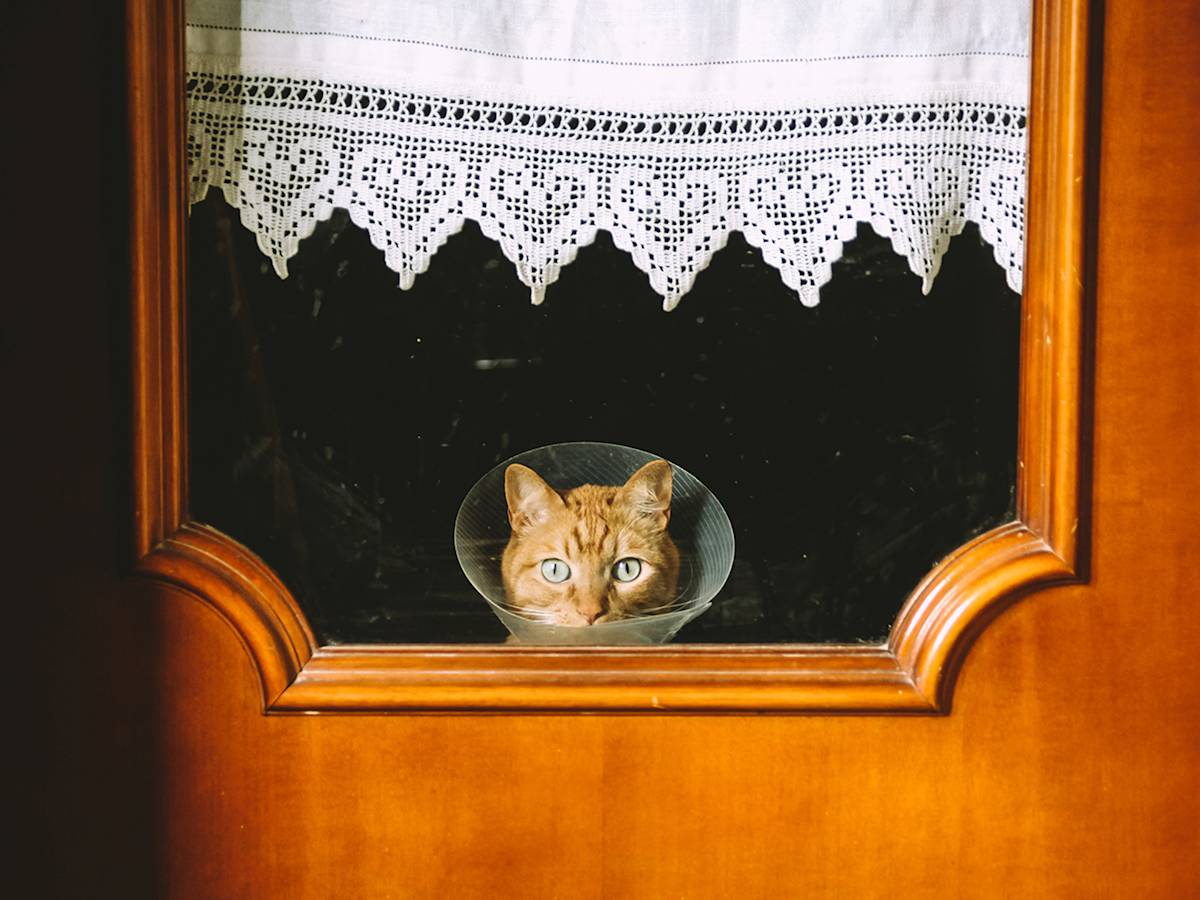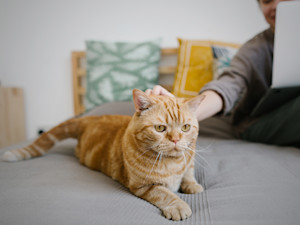How Often Should You Take Your Cat to the Vet?
Get thy cat to a vet, even if it’s a struggle to get them out the door.
In This Article:
How Often Do Cats Need to See The Vet? What Is Done at a Cat Checkup? How to Prepare Your Cat Before a Vet Visit How Much Do Cat Vet Visits Cost? Being Proactive About Your Cat’s Health Pet Insurance for Cats
Loading a spirited cat into a carrier requires some prowess, and there is still no guarantee that you’ll emerge from the experience without a scratch. Still, a trip to the vet is essential to your cat’s wellbeing. So, as much as you may want to avoid the whole ordeal, consider what vets have to say about how often you should take a cat to the veterinarian at every life stage.
How often do cats need to see the vet?
Kittens
“Kittens require a lot of care, and need to go to the vet a lot during their first year,” veterinarian Dr. Amy Stoneopens in new tab says. These initial wellness visits are key to keeping your cat healthy. Besides a general exam, your kitty will need a blood test for feline leukemia and feline immunodeficiency viruses, a fecal test for parasites, initial vaccinations (plus subsequent booster shots), microchipping, deworming, and spaying or neutering.
How much do you spend on your pet per year?
During these checks, your vet will confirm that your kitten is hitting all of their growth milestones and shows no signs of congenital defects such as a cleft palate, extra toes, undescended testicles, or neurological deficits that could upset their balance.
More specifically, the vaccines they need are as follows.
Core vaccines for kittens (essential for all cats)
FVRCP vaccine (feline viral rhinotracheitis, calicivirus, panleukopenia)
Start: Six to eight weeks old
Boosters: Every three to four weeks until 16 to 20 weeks old
Booster after kitten series: One year later, then every one to three years, depending on risk and lifestyle
Rabies vaccine
Start: Around 12 to 16 weeks old (varies by local law)
Booster after first dose: One year later
Then: Every one to three years, depending on vaccine type and legal requirements
Non-core vaccines (given based on risk/lifestyle)
Feline leukemia virus (FeLV)
Start: Around eight to 10 weeks old
Booster: Three to four weeks, after first dose
Booster after kitten series: One year later
Then: Annually, if your cat goes outdoors or lives with FeLV+ cats
Note: Even indoor-only kittens often receive the FeLV vaccine during their first year, in case they escape outdoors.
Adult cats
The above all add up to roughly five vet visits before your cat even celebrates their first birthday. After that, Stone recommends annual visits for preventive care: exams, blood work, heartworm, and flea/tick preventatives (if you have outdoor cats), and prescriptions as needed.
If your cat appears to be in good shape, it may be tempting to skip those annual check-ups. We empathize — you can never unhear the yowling. And don’t even get us started on the parental guilt that comes with subjecting your kitty to the stress of a vet clinic. Neither of which, sorry to say, are reasons Dr. Bruce Kornreich, director of the Cornell Feline Health Center, wants to hear. There are booster vaccines that are necessary when your kitten reaches one year of age, as well as during subsequent annual visits.
A couple of years ago, the American Veterinary Medical Association found that only 54 percent of cat parents make the annual trip to the vet — yikes. “You want to identify problems as early as possible,” Kornreich says. “The sooner you catch a problem, the more likely a medical or surgical outcome [will] be successful.” Your vet also provides more than preventive care. Whenever you notice a change in your cat’s health, consult your veterinarian, not Google.
Symptoms such as diarrhea, vomiting, increased thirst, rapid breathing, and nasal discharge are all signs that your cat needs immediate care. “If you don’t call, whatever [the problem is] could get a lot worse,” Stone adds.
Senior cats
As the number of candles on your cat’s birthday cake inches up, so should the frequency of their vet visits. Kornreich recommends that cats over 10 years old see a vet twice a year. “As cats get older, the incidence of disease goes up,” he says.
Diabetes, heart disease, hyperthyroidism, arthritis, cancer, and dental disease are all more common in older cats. Biannual visits allow your veterinarian to check for signs that something is amiss and increase the odds that your geriatric cat remains as healthy as possible during their golden years. Also, some vaccines are still needed as your cat ages, such as rabies. (You can’t argue with that.)
What is typically done at a cat checkup?
Your vet will begin by getting a thorough history of your cat. Knowing how your cat has been doing at home is very important. The veterinarian will want to know about your pet’s eating habits, drinking habits, urination and defecation patterns, behavior, and any concerns you may have. A thorough physical exam is next. This will include an examination of your cat’s ears, eyes, nose and throat, teeth, and skin, as well as listening to your kitty’s heart and lungs. They will examine your cat’s condition and weight and palpate the abdomen to assess the organs.
If any vaccinations are needed (see the vaccine requirements, above), they may be administered, depending on your cat’s age, lifestyle, health, and vaccination history. Your vet will discuss the results of the physical exam with you and may recommend bloodwork if anything abnormal is discovered or if your kitty is of a certain age.
If your cat is due for a fecal exam, your vet may request a stool sample to screen for internal parasites. They may also discuss flea, tick, and heartworm preventio n.
How to prepare your cat before a vet visit
There are several steps to take before the vet visit to help make your cat more comfortable.
Leave the cat carrier out with treats or bedding inside for a few days to make it inviting, so your kitty can lose their fear of it. A better idea is to always leave it out, so your cat will be familiar with it and even sleep in it sometimes.
To prevent car sickness, limit your cat’s food intake before travel.
If you have concerns or questions, write them down beforehand, so you don’t forget to ask during the visit.
Try to remain calm and speak soothingly to your cat, because they can sense your anxiety.
If your cat is particularly fearful or aggressive during car rides or vet visits, ask your veterinarian about using a mild sedative or pheromone spray.
How much do cat vet visits cost?
The cost of a cat vet visit can vary by your location, the services provided, and whether the visit is routine or due to an illness. On average, a basic wellness exam costs between $50 and $100. Vaccinations typically add $20 to $40, per shot. Fecal exams may cost $25 to $45, and bloodwork panels can range from $100 to $200.
Dental cleanings, imaging (such as X-rays), or diagnostic procedures for sick cats can significantly drive up costs. Emergency visits or specialty services may cost hundreds. Regular checkups can help prevent costly treatments later on by identifying issues early.
Taking steps to be proactive about your cat’s health
Caring for your cat between vet visits is just as important as attending annual exams. By being observant and proactive, you can catch health problems before they become serious.
Be aware of changes in your cat’s behavior and health
Cats are very good at hiding their problems from their cat parents. One day, they can seem fine, and the very next, they will finally show you that they are sick. Always watch for changes in behavior, appetite, thirst, and bathroom habits. Increased hiding, vocalization, or aggression can also signal pain or distress. If your kitty is vomiting, experiencing diarrhea, or demonstrating weight changes, consult your veterinarian.
Understand typical cat health issues to spot them early
Common health problems in cats include dental disease, obesity, urinary tract infections, kidney disease, hyperthyroidism, and diabetes. Learn the signs of these potentially dangerous conditions, so you can spot them early.
One symptom most cat diseases have in common is a change in thirst, urination, or appetite. Being familiar with these conditions can help you spot early symptoms. For example, excessive thirst and urination may indicate issues with the kidneys or thyroid. Regular blood and urine tests, especially for middle-aged and senior cats, are key to early detection.
Dental care and regular cleanings
Dental disease is one of the most common health issues in cats and one of the most ignored. It can lead to serious complications if left untreated. Regular dental exams and professional cleanings, typically recommended once a year, help prevent plaque buildup, gingivitis, and tooth loss. At-home dental care, including brushing, dental treats, and dental water additives, can also support your cat’s oral health.
Does pet insurance make sense for your cat?
Few pet parents have used their pet insurance and regretted buying it. It not only saves money, but it saves lives. When an emergency comes along and costs thousands of dollars, pet insurance can mean the difference between life and death. Many pet parents don’t enroll in the basic preventative plans because basic annual care is usually affordable. It’s the illnesses and accidents that can be overwhelming.
Shop around. Many plans exclude pre-existing conditions, so it’s best to enroll your cat while they’re still young and healthy. Before choosing a policy, compare coverage options, deductibles, reimbursement rates, and exclusions to ensure you understand the details. Some pet parents find that a dedicated savings account for vet expenses works better for their needs than monthly premiums.
Bottom line
The number of cats taken to the vet still doesn’t begin to match that of dogs.
Routine vet visits are vital for your cat’s overall health and longevity. They need vaccinations, dental cleanings, and early detection of illnesses. Regular checkups address potential issues before they develop into significant problems.
Preparing your cat ahead of time, being observant of changes at home, and considering pet insurance are all ways to stay on top of their health care.
References
Bir, Courtney, et al. “Familiarity and Use of Veterinary Services by US Resident Dog and Cat Owners.” Animals: An Open Access Journal from MDPI, vol. 10, no. 3, 13 Mar. 2020, www.ncbi.nlm.nih.gov/pmc/articles/PMC7143178/#:~:text=According%20to%20the%202017%E2%80%932018opens in new tab, https://doi.org/10.3390/ani10030483opens in new tab.
Kogan, Lori R., et al. “The Impact of COVID on Cat Guardians: Veterinary Issues.” Animals, vol. 11, no. 3, 25 Feb. 2021, p. 603, doi.org/10.3390/ani11030603opens in new tab.
Mariti, Chiara, et al. “Guardians’ Perceptions of Cats’ Welfare and Behavior Regarding Visiting Veterinary Clinics.” Journal of Applied Animal Welfare Science, vol. 19, no. 4, 26 Apr. 2016, pp. 375–384, doi.org/10.1080/10888705.2016.1173548opens in new tab.












